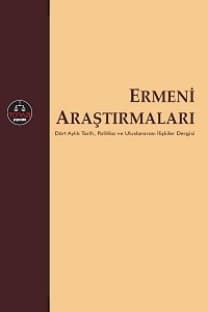CİNAYETİN CEZASIZ KALMASI: SOGHOMON TEHLİRİAN, ASALA VE ADALET KOMANDOLARI, 1921–1984
70 ve 80’li yıllarda Ermeni terörizmi üzerine yapılan çalışmalarınbüyük çoğunluğu, Ermeni Devrimci Federasyonu’nun Nemesis olarakadlandırılan 20’li yıllarda eski Osmanlı yöneticilerine yönelik suikastkampanyasının yüzeysel bir tartışması ile başlar. Bu çalışma, iki çatışmadönemi arasındaki bağlantının daha derin bir analizini yapmaya girişmekteve aslında Soghomon Tehlirian’ın Batı’daki Türk ve Talat karşıtıpropaganda ve Tehlirian’ın mahkemedeki ifadesi neticesinde Talat’ıöldürmek suçundan beraat etmesinin, Ermeni Diasporası içinde bir şiddetkültünün oluşmasına zemin hazırladığını öne sürmektedir. Bu şiddet kültüOcak 1973 tarihinde trajik bir şekilde tekrar su yüzüne çıkmış ve 1980’lerinortasına kadar devam etmiştir. 1915 olaylarının üstünden 50 yıl ve üç kuşakgeçmesine rağmen Tehlirian’ın beraat kararının ortaya koyduğu emsal,tekrar bu şiddeti haklı göstermek için kullanılmıştır. Fakat bütün bunlardakitrajik ironi Tehlirian’ın masumiyetini, iyi yönetilmiş ve uydurulmuş birsavunma ile kazanmasıdır. Bu da Tehlirian’ın hikâyesi anlatılırken göz ardıedilmiş ve hala edilen önemli bir detaydır
Anahtar Kelimeler:
Soghomon Tehlirian, ASALA, Adalet Komandoları
GETTING AWAY WITH MURDER: SOGHOMON TEHLIRIAN,ASALA AND THE JUSTICE COMMANDOS, 1921-1984
Most research on Armenian terrorism during the 1970s and1980s begins with a cursory discussion of the Armenian RevolutionaryFederation’s assassination campaign against former Ottoman officials,known as Nemesis, during the early 1920s.This paper will attempt a deeperanalysis of the links between these two periods of violence and argue thatthe acquittal of Soghomon Tehlirian in the assassination of Talaat, primarilya factor of the anti-Turkish and anti-Talaat propaganda in the west andTehlirian’s court testimony, facilitated and sustained a cult of violencewithin the Armenian diaspora. This cult of violence tragically resurfaced inJanuary 1973 and lasted until the mid-1980s. Although 50 years and threegenerations removed from the events of 1915, the precedent set by Tehlirian’sacquittal was again used to justify the violence. The tragedy in all of this,however, is that Tehlirian’s innocence was attained through means of afabricated and well-coached defense. A detail that was, and is, still largely leftout when Tehlirian’s tale is told
___
- Birincil Kaynaklar
- The New York Times (NYT)
- The Times (London)
- The Armenian Observer (AO)
- The Armenian Reporter (AR)
- The Armenian Weekly (AW)
- The Trial of Soghomon Tehlirian http://cilicia.com/armo_tehlirian.html İkincil Kaynaklar
- ALEXANDER, Edward. A Crime of Vengeance: An Armenian Struggle for Justice. New York: The Free Press, 1991.
- AVAKIAN, Lindy V. The Cross and the Crescent. Phoenix, AZ: UCS Press, 1989. (İlk yayınlanışı: Los Angeles, CA: De Vorss, 1965).
- BALAKIAN, Peter. The Burning Tigris: The Armenian Genocide and America’s Response. New York: HarperCollins, 2003. Kindle Edition. BOBELIAN, Michael. Children of Armenia: A Forgotten Genocide and the Century-Long Struggle for Justice. New York: Simon & Schuster, 2009.
- CHALIAND, Gerard and Yves Ternon. The Armenians: From Genocide to Resistance. London: Zed Press, 1983.
- DEROGY, Jacques. Resistance and Revenge: The Armenian Assassination of The Turkish Leaders Responsible for the 1915 Massacres and Deportations. New Brunswick, NJ: Transaction Publishers, 1990. İlk, Fransız Yayın, 1986.
- GUNTER, Michael M. “Pursuing the Just Cause of their People”: A Study of Contemporary Armenian Terrorism. Westport, CT: Greenwood Press, 1986.
- HYLAND, Francis P. Armenian Terrorism: the Past, the Present, the Prospects. Boulder, CO: Westview Press, 1991.
- KURZ, Anat and Ariel Merari. ASALA—Irrational Terror or Political Tool. Boulder, CO: Westview Press, 1985.
- LÜTEM, Ömer Engin. Armenian Terrorism. Ankara, Turkey: Avrasya İncelemeleri Merkezi, 2007.
- MILLER, Donald E. and Lorna Touryan Miller. Survivors: An Oral History of the Armenian Genocide. Berkeley, CA: The University of California Press, 1993.
- MORGENTHAU, Henry. Ambassador Morgenthau’s Story: A Personal Account of the Armenian Genocide. New York: Cosmo Classics, 2008.
- SHIRAGIAN, Arshavir. The Legacy: Memoirs of an Armenian Patriot. Boston: Hairenik Press, 1976.
- TERNON, Yves. The Armenian Cause. Delmar, NY: Caravan Books, 1985.
- ÜNAL, Şeref. Trial of Salomon Teilirian: Assassination of Talat Pasha, Berlin 2-3 June 1921. New York: Okey, 2007.
- VARTABEDIAN, Sarah. “Commemoration of an Assassin: Representing the Armenian Genocide.” Yüksek Lisans Tezi, University of North Carolina Chapel Hill, 2007.
- YEGHIAYAN, Vartkes. The Case of Soghomon Tehlirian. Glendale, CA: Center for Armenian Remembrance, 2006.
- ISSN: 1303-068X
- Yayın Aralığı: Yılda 2 Sayı
- Başlangıç: 2001
- Yayıncı: Avrasya İncelemeleri Merkezi
